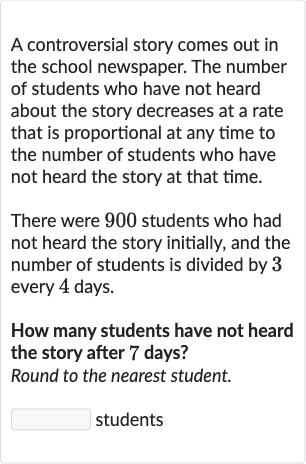AI tutor
Welcome to Bytelearn!
Let’s check out your problem:

A controversial story comes out in the school newspaper. The number of students who have not heard about the story decreases at a rate that is proportional at any time to the number of students who have not heard the story at that time.There were students who had not heard the story initially, and the number of students is divided by every days.How many students have not heard the story after days?Round to the nearest student. students
Full solution
Q. A controversial story comes out in the school newspaper. The number of students who have not heard about the story decreases at a rate that is proportional at any time to the number of students who have not heard the story at that time.There were students who had not heard the story initially, and the number of students is divided by every days.How many students have not heard the story after days?Round to the nearest student. students
- Understand and Determine Decay Type: Understand the problem and determine the type of decay. The problem states that the number of students who have not heard the story decreases at a rate proportional to the number of students who have not heard it at any given time. This is an example of exponential decay.
- Identify Initial Quantity and Rate: Identify the initial quantity and the decay rate.The initial number of students who have not heard the story is . The number of students is divided by every days, which means after days, only one-third of the students have not heard the story.
- Calculate Decay Factor: Calculate the decay factor for each -day period.The decay factor for each -day period is , as the number of students who have not heard the story is divided by .
- Determine Complete Periods: Determine the number of complete -day periods in days.Since days is not a multiple of , we have one complete -day period and an additional days. We will first calculate the number of students who have not heard the story after the complete -day period.
- Calculate Students After Days: Calculate the number of students who have not heard the story after the complete -day period.Number of students after days Initial number of students Decay factor students
- Determine Daily Decay Rate: Determine the daily decay rate.Since the number of students is divided by every days, we need to find the equivalent daily decay rate. The daily decay rate is the fourth root of because raised to the power of equals .
- Calculate Fourth Root: Calculate the fourth root of to find the daily decay rate.Daily decay rate =
- Calculate Students After Days: Calculate the number of students who have not heard the story after the additional days.Number of students after days = Number of students after days (Daily decay rate)
- Perform Calculation: Perform the calculation for the number of students after days.Number of students after days =
- Calculate Exact Value: Calculate the exact value and round to the nearest student.Number of students after days
More problems from Rate of travel: word problems
QuestionGet tutor help
QuestionGet tutor help
QuestionGet tutor help
QuestionGet tutor help
QuestionGet tutor help
QuestionGet tutor help
QuestionGet tutor help
QuestionGet tutor help
QuestionGet tutor help
